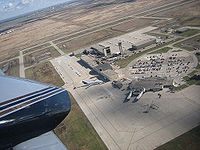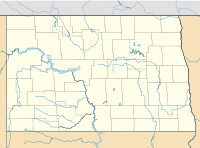- Grand Forks International Airport
-
"KGFK" redirects here. For the radio station in Grand Forks, ND with the call sign KGFK, see KGFK (AM).
Grand Forks International Airport 
IATA: GFK – ICAO: KGFK – FAA LID: GFK Location of the Airport in North Dakota Summary Airport type Public Operator Grand Forks Regional Airport Authority Location Grand Forks, North Dakota Elevation AMSL 845 ft / 258 m Coordinates 47°56′57″N 097°10′34″W / 47.94917°N 97.17611°W Website Runways Direction Length Surface ft m 9L/27R 4,206 1,282 Concrete 17L/35R 3,900 1,189 Concrete 17R/35L 7,349 2,240 Asphalt 9R/27L 3,300 1,006 Concrete Statistics (2006) Aircraft operations 224,942 Sources: FAA[1] and airport web site[2] Grand Forks International Airport (IATA: GFK, ICAO: KGFK, FAA LID: GFK) is a public airport located five miles (8 km) northwest of the central business district of Grand Forks, a city in Grand Forks County, North Dakota, United States. GFK has no scheduled passenger airline service out of the country but receives its international title (like many other airports) because it has customs service available for general aviation aircraft arriving from Canada and other countries.
The airport, sometimes called Mark Andrews International Airport after Mark Andrews, a former U.S. House Representative and U.S. Senator from North Dakota, is owned by the Grand Forks Regional Airport Authority[1] and located on U.S. Highway 2, around four miles (6 km) west of Interstate 29, within city limits in a detached section of the city that is surrounded by Rye Township.
In 2009, the airport's FAA control tower was the 23rd busiest in the nation, with a total of 346,165 tower operations.[3] Approximately 90% of all airport operations at GFK are flights operated by the University of North Dakota's John D. Odegard School of Aerospace Sciences which is based on the field.
Contents
Facilities
Terminal
The now closed original passenger terminal at GFK was built in 1964. Outside terminal security are the Delta and Allegiant Airlines ticketing counters, a restaurant, a gift shop and a waiting area. After passing through security screening there is a small waiting area that served the terminal's two passenger gates.
In the mid-2000s, discussion began of upgrading or totally replacing the terminal as it has structural and safety problems and leaves little to no room for expansion. Findings from a study commissioned by the Grand Forks Regional Airport Authority were released in early 2005. The study, which was done by Ulteig Engineers, gave the Airport Authority options for the future of the passenger terminal.
One option was to keep the terminal as is and not perform any upgrades. The consulting group did not recommend this as the terminal has too many structural and safety problems. The list of problems include: mold growth, roof leakage, differential settlement, blocking runway line of sight, passenger boarding, potential equipment damage from basement flooding, outdated electrical and mechanical systems, no sprinkler system, code deficiencies, insufficient parking setback, and interior traffic circulation issues. The terminal could be rehabilitated for $18.3 million, however, that would leave many issues unresolved and leave no room for expansion.
The consulting group recommended that a brand new passenger terminal would the best solution to the current terminal's problems. Five locations for a new terminal were evaluated favoring a site between the cargo apron and general aviation apron. Ground was broken on the new terminal in July 2009, with completion expected in 2011. The building will be named the Byron L Dorgan Terminal in honor of retiring North Dakota Senator Byron Dorgan. It was opened and dedicated on August 30th, 2011.
UND Aerospace
A majority of flight operations (takeoff/landing) at GFK is from the University of North Dakota. The UND Aerospace Foundation occupies the northeastern (Bravo), and eastern (Charlie) ramps on the airport. UND operates a fleet over 100 aircraft including Cessna 172's, 150's, Piper Warriors, Seminoles, Arrows, two Beechcraft King Air 90's and a Decathlon for flight training. UND also owns a Cessna Citation, however, this is for atmospheric research and not used for flight training. Several buildings complement such a fleet of aircraft, including a Dispatch center, a full time maintenance center, and dedicated line support personal and much more.
Runways
Grand Forks International Airport covers an area of 1,618 acres (655 ha) which contains four runways:[1]
- Runway 9L/27R: 4,206 × 100 ft (1,282 × 30 m), Concrete
- Runway 17L/35R: 3,900 × 75 ft (1,189 × 23 m), Concrete
- Runway 17R/35L: 7,349 × 150 ft (2,240 × 46 m), Asphalt
- Runway 9R/27L: 3,300 × 60 ft (1,006 × 18 m), Concrete
Due to the increased amount of general aviation traffic, primarily from the UND Aerospace flight training school, a fourth runway has been completed. Located in the southeastern portion of the airport, it will operate as a parallel east/west runway and is named 9R/27L. The previous runway 8/26 was renamed in October 2008 to 9L/27R in preparation for the new runway.
Aircraft
For the 12-month period ending December 31, 2008, the airport had 241,459 aircraft operations, an average of 662 per day: 93% air taxi, 5% general aviation, 1% scheduled commercial and 1% military.[3]
GFK Flight Support
GFK Flight Support, the fixed base operator at the airport, completed construction of a new $4.5 million dollar facility in Fall 2008. This 45,000 sq ft (4,200 m2) facility increased GFK Flight Support's heated hangar and aircraft support space to 130,000 sq ft (12,000 m2) making it the largest aircraft service center in North Dakota. The previous facilities are now used by wing of the U.S. Customs and Border Protection, housing a number of government aircraft and helicopters.[4]
Airlines and destinations
Airlines Destinations Allegiant Air Las Vegas, Orlando-Sanford [begins November 17], Phoenix/Mesa Delta Connection operated by Mesaba Airlines Minneapolis/St.Paul Delta Connection operated by Pinnacle Airlines Minneapolis/St. Paul Delta Connection operated by SkyWest Airlines Minneapolis/St. Paul Cargo
Airlines Destinations FedEx Express Memphis, Sioux Falls FedEx Feeder operated by Corporate Air Minot, Bismarck, Dickinson, Williston, ND. Thief River Falls, Bemidji, MN Alpine Air Express Bismarck, ND See also
References
- ^ a b c FAA Airport Master Record for GFK (Form 5010 PDF), effective 2007-12-20
- ^ Grand Forks International Airport, official web site
- ^ a b FAA ATADS Report
- ^ "GFK Flight Support To Build State-Of-The-Art Corporate Jet Center". press release. Grand Forks International Airport. 2007-08-27. http://www.gfkairport.com/html/gfkfs.htm.
External links
- GFK Flight Support, the fixed base operator (FBO)
- FAA Airport Diagram (PDF), effective 20 October 2011
- Resources for this airport:
- AirNav airport information for KGFK
- ASN accident history for GFK
- FlightAware airport information and live flight tracker
- NOAA/NWS latest weather observations
- SkyVector aeronautical chart for KGFK
- FAA current GFK delay information
City of Grand Forks Topics Airport · Climate · Flag · History · Major roads · Mayors · Media · Notable people · Parks · Public schools · Public transit · Sister cities · UND
Neighborhoods Categories:- Airfields of the United States Army Air Forces in North Dakota
- Buildings and structures in Grand Forks County, North Dakota
- Greater Grand Forks
- Airports in North Dakota
Wikimedia Foundation. 2010.


